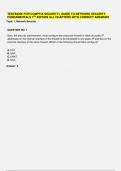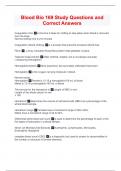TESTBANK FOR COMPTIA SECURITY+ GUIDE TO NETWORK SECURITY
FUNDAMENTALS 7TH EDITION ALL CHAPTERS WITH CORRECT ANSWERS
Topic 1, Network Security
QUESTION NO: 1
Sara, the security administrator, must configure the corporate firewall to allow all public IP
addresses on the internal interface of the firewall to be translated to one public IP address on the
external interface of the same firewall. Which of the following should Sara configure?
A. PAT
B. NAP
C. DNAT
D. NAC
Answer: A
,Explanation:
Port Address Translation (PAT), is an extension to network address translation (NAT) that permits
multiple devices on a local area network (LAN) to be mapped to a single public IP address. The
goal of PAT is to conserve IP addresses.
Most home networks use PAT. In such a scenario, the Internet Service Provider (ISP) assigns a
single IP address to the home network's router. When Computer X logs on the Internet, the router
assigns the client a port number, which is appended to the internal IP address. This, in effect,
gives Computer X a unique address. If Computer Z logs on the Internet at the same time, the
router assigns it the same local IP address with a different port number. Although both computers
are sharing the same public IP address and accessing the Internet at the same time, the router
knows exactly which computer to send specific packets to because each computer has a unique
internal address.
QUESTION NO: 2
Which of the following devices is MOST likely being used when processing the following?
1 PERMIT IP ANY ANY EQ 80
2 DENY IP ANY ANY
A. Firewall
B. NIPS
C. Load balancer
D. URL filter
,Answer: A
Explanation:
Firewalls, routers, and even switches can use ACLs as a method of security management. An
access control list has a deny ip any any implicitly at the end of any access control list. ACLs deny
by default and allow by exception.
QUESTION NO: 3
The security administrator at ABC company received the following log information from an external
party:
10:45:01 EST, SRC 10.4.3.7:3056, DST 8.4.2.1:80, ALERT, Directory traversal
10:45:02 EST, SRC 10.4.3.7:3057, DST 8.4.2.1:80, ALERT, Account brute force
10:45:03 EST, SRC 10.4.3.7:3058, DST 8.4.2.1:80, ALERT, Port scan
The external party is reporting attacks coming from abc-company.com. Which of the following is
the reason the ABC company’s security administrator is unable to determine the origin of the
attack?
A. A NIDS was used in place of a NIPS.
B. The log is not in UTC.
C. The external party uses a firewall.
D. ABC company uses PAT.
Answer: D
Explanation:
PAT would ensure that computers on ABC’s LAN translate to the same IP address, but with a
different port number assignment. The log information shows the IP address, not the port number,
making it impossible to pin point the exact source.
QUESTION NO: 4
Which of the following security devices can be replicated on a Linux based computer using IP
tables to inspect and properly handle network based traffic?
A. Sniffer
B. Router
, C. Firewall
D. Switch
Answer: C
Explanation:
Ip tables are a user-space application program that allows a system administrator to configure the
tables provided by the Linux kernel firewall and the chains and rules it stores.
QUESTION NO: 5
Which of the following firewall types inspects Ethernet traffic at the MOST levels of the OSI
model?
A. Packet Filter Firewall
B. Stateful Firewall
C. Proxy Firewall
D. Application Firewall
Answer: B
Explanation:
Stateful inspections occur at all levels of the network.
QUESTION NO: 6
The Chief Information Security Officer (CISO) has mandated that all IT systems with credit card
data be segregated from the main corporate network to prevent unauthorized access and that
access to the IT systems should be logged. Which of the following would BEST meet the CISO’s
requirements?
A. Sniffers
B. NIDS
C. Firewalls
D. Web proxies
E. Layer 2 switches
Answer: C
Explanation:
The basic purpose of a firewall is to isolate one network from another.





